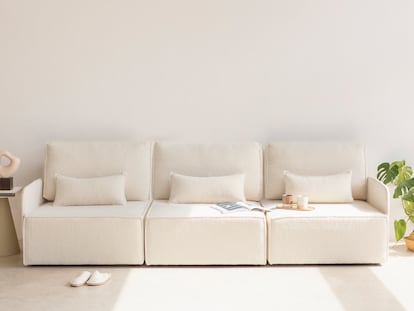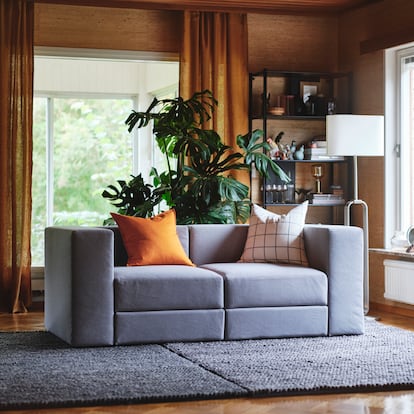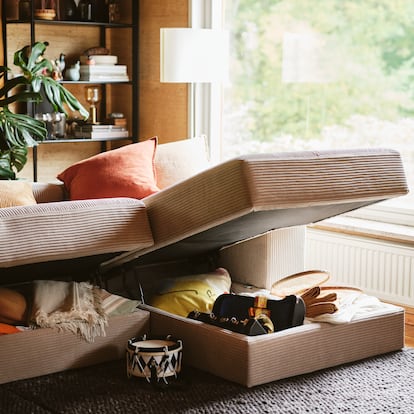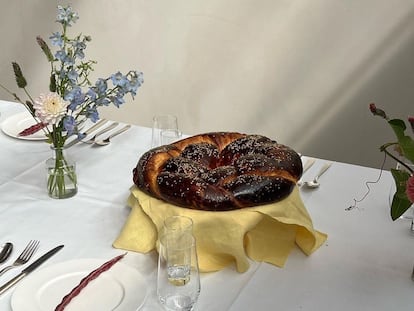The unexpected return of the modular sofa: Multifunctional, practical and straight from the ‘70s
The necessity of creating multiuse spaces, coupled with limited access to affordable housing, have defined the success of this piece of furniture as the definitive space solution

Three defining factors have led to the growing success of modular sofas. The first has to do with the actual functionality of space, especially in the living room. The second is aesthetic, and closely tied to the unstoppable return of 1970s-era decorative trends. The third, however, is a bit of a party pooper, and consists of the impossibility faced by a large part of the population (and not only the younger generations) of finding a stable, long-lasting place to live. There’s quite a story to tell when it comes to explaining the success of a piece of furnishing such as the modular sofa in socioeconomic terms.
Both the functional and aesthetic reasons behind its triumph are rooted in the domestic consequences of the Covid pandemic. Among the many side effects of confinement, one of the most curious, and possibly the most negative, was the reinvention of spaces in the home. Spending more time in one’s house triggered our discovery of its feng shui errors, ways that it could be improved, and tricks to make our nest a more pleasant space. Social networks like Instagram, TikTok and Pinterest echoed these concerns through the algorithm, transforming into sources for ideas and inspiration.
As it became clear that remote work was here to stay, the need to find an area in the home that could easily shift into an office or study nook became imperative. Hybridizing spaces in a functional yet pleasant manner, with a focus on aesthetics, became a humble design objective. But it’s not only about making one’s living room a place suitable for work that once took place in an office. It can (and should) also be a place of leisure: a cinema room or gaming center that could, of course, shift into being an area for rest and basic socializing.
The words of Manuel Delgado, head of strategic interior design at Ikea Spain, serve to contextualize the triumph of modular sofa models: “The living room is one of the spaces in the house that has evolved the most, and is currently the room in which most activities and uses take place. This shifts, depending on time of day or day of the week. For example, we can telework in the morning, eat lunch at midday, do chores with the kids, binge on TV series, scroll on our phone or disconnect, and of course, take a nap.” The Swedish giant’s Jättebo sofa series, whose models are divided into individual modules with under-seat storage, embodies both the growing relevance of the modular sofa and evolution of our uses of the living room. Each seating module or chaise longue can be purchased individually and used separately or combined in different ways, depending on the requirements of the space.

“As a consequence of the flexibility of life in the living room, design is evolving towards multifunctional, versatile and modular furniture,” explains Delgado, who points out that this is the purpose of a modular sofa that can be reconfigured, like those in the Jättebo series. They make it possible to open up space with a reading nook, find solutions for small living rooms, and create a divider when placed in the middle of a room.
The drive to create a peaceful haven
Followers of prevailing décor trends know that the ‘70s aesthetic is back. You can see it in furniture that, although functional, does not abandon the pursuit of quality finishes and a certain aesthetic aspiration that, when properly recreated, results in a calm and cozy setting for those who live with them. This is evident in their preference for wood finishes, the presence of plants and the inclination towards more muted and serene shades of green, but it also translates into furniture designed for relaxation, like sofas and armchairs.
The Instagram account Circa 70s Interiors is a reminder of how interior design publications of the era shared possibilities for modular sofas that, at times, were explored to the point of exaggeration, and the curious multifunctional designs that resulted in extravagant pieces that could shift from sofa into entertainment center, for rest and socialization. Such is the case of Aaron Donner’s experimental Pleasure Island design, a waterbed that incorporated an entire entertainment center for listening to music on its soft surface. Or the Safari modular sofa design by Archizoom, an avant-garde Italian design collective, which was built to close in on itself in a circular layout. These are odd examples that were not at all representative of the reality even for the period’s most modern and expensive homes, but they do serve to highlight how questions of functionality, comfort and the living room as the nerve center of the home became the focus of interior design. As in 2023, during the 1970s we were in pursuit of a cozy and quiet home, designed for extended stays and versatility of use.
Really Nice Things is a Spanish furniture and interior design brand that has also gone in on the modular sofa trend with its catalogue’s Lea and Harper models, which combine individual modules with or without armrests alongside the option of a chaise longue. Its founder, Andrés Gramage, recognizes the virtues of ‘70s-inspired design. “We love the ‘70s for their fun, colorful and eclectic style. It was a prodigious decade, full of cultural changes,” says Gramage, who locates that love of calmness so typical of ‘70s furniture in Really Nice Things’ Harper sofa. “The sofa is based on strong, geometric lines that are capable of transmitting serenity. It is upholstered in corduroy, synonymous with warmth, to reinforce that retro but contemporary air.”
A design for a contemporary problem
We are moving more and more, with all the corresponding emotional baggage that constant movement creates for a population no longer so young. Faced with the impossibility not only of buying a home of their own, but also of finding a place they can rent solo, without roommates, people are leaving pieces of their lives in more places, even after the age of 30.
In the face of constant movement between one rental aparment to another, having our own furniture has become a luxury of our times. Even if we do buy pieces, they need to be light and as easy to transport as possible. Nothing that can break when reassembled in a new location. This is the other reason, a less sunny one, for why modular sofas are hitting their sweet spot as a furniture solution. They hold the promise of being able to adapt to new spatial conditions, and are designed to be reconfigured and easy to move.

When Delgado is asked about the adaptability of modular sofas, as in those of the Jättebo series, he brings up the idea of what he calls the nomadic world, and its growing relevance. Small spaces can be better utilized and optimized with a modular design: “Modularity and multifunctionality are key in planning small spaces, so Jättebo is a highly recommended sofa for that kind of home. Since its modular, you can create minimal, single-seat sofas or a single chaise longue module, either for one-person households or larger ones.”
As rents continue to rise, the space we have to accommodate objects becomes smaller. The furnishings and interior design choices we make reflect this phenomenon, becoming a mirror for larger social and economic realities. The story of the triumph of the modular sofa is just one of these narratives. It’s just the tip of an iceberg, speaking to big aesthetic aspirations in the smallest of spaces.
Sign up for our weekly newsletter to get more English-language news coverage from EL PAÍS USA Edition
Tu suscripción se está usando en otro dispositivo
¿Quieres añadir otro usuario a tu suscripción?
Si continúas leyendo en este dispositivo, no se podrá leer en el otro.
FlechaTu suscripción se está usando en otro dispositivo y solo puedes acceder a EL PAÍS desde un dispositivo a la vez.
Si quieres compartir tu cuenta, cambia tu suscripción a la modalidad Premium, así podrás añadir otro usuario. Cada uno accederá con su propia cuenta de email, lo que os permitirá personalizar vuestra experiencia en EL PAÍS.
¿Tienes una suscripción de empresa? Accede aquí para contratar más cuentas.
En el caso de no saber quién está usando tu cuenta, te recomendamos cambiar tu contraseña aquí.
Si decides continuar compartiendo tu cuenta, este mensaje se mostrará en tu dispositivo y en el de la otra persona que está usando tu cuenta de forma indefinida, afectando a tu experiencia de lectura. Puedes consultar aquí los términos y condiciones de la suscripción digital.
More information
Archived In
Últimas noticias
The murder of Michele and Rob Reiner: A tale of horrific days in Hollywood
Trump orders a ‘complete blockade of sanctioned oil tankers’ going to and from Venezuela
Not all insomnia is the same: Study identifies five subtypes and paves the way for personalized treatment
The United States designates Clan del Golfo as a foreign terrorist group
Most viewed
- ‘El Limones’ and the growing union disguise of Mexican organized crime
- Christian Louboutin: ‘Young people don’t want to be like their parents. And if their parents wear sneakers, they’re going to look for something else’
- ‘We are dying’: Cuba sinks into a health crisis amid medicine shortages and misdiagnosis
- A mountaineer, accused of manslaughter for the death of his partner during a climb: He silenced his phone and refused a helicopter rescue
- The low-cost creative revolution: How technology is making art accessible to everyone










































